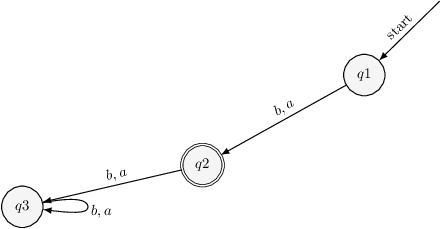Solution file
Getting Started
To solve exercises of a particular topic, start by carefully reading the exercise tasks. For instance, the tutorial exercises above contain the following three tasks:
\begin{enumerate}[label=\alph*)] \item a) "Give a deterministic finite automaton (DFA) $d_1$ recognizing the language of the regular expression $a + b$.'' \item b) "Give a non-deterministic finite automaton (NFA) $n_1$ recognizing the language of the regular expression $a^{*}$.'' \item c) "Give a regular expression $r_1$ recognizing the language $\{ w \in {\{ a, b \}}{}^* \ \vert\ |w|_b$ is even and $w$ does not end with a $b$ $\}$.'' \end{enumerate}
There are essentially two things to know about how to write your solutions:
Whether your solution is a DFA, a NFA, or a regular expression, giving it a name follows the same syntax:
let 'name' = 'your solution'
For instance, the names of solutions for the three tasks above must be
d1, n1, and r1 respectively,
and the submission file for the tutorial exercises should look like
let d1 = ...
let n1 = ...
let r1 = ...
Let's see now how to write down the solutions themselves.
Syntax of Finite State Automata
A finite state automaton consists of a set of states and a set of labelled
transitions between two given states introduced respectively by the
following keywords with colon ":" sign :
states:
...
delta:
...
A state is declared by an alphanumerical ([a-z A-Z 0-9]+) identifier
followed by a semicolon ";".
Each automaton should have exactly one initial state and zero or more final states.
The initial state is marked by "-->" sign and by "<->" sign if it is also
final.
A final state is marked by "<--" sign.
A labelled transition between two given states q1 and q2 consists of a triplet
q1 'label-option' q2;
where 'label-option' is either an alphanumerical ([a-z A-Z 0-9]) character
identifier or a blank space. The latter case corresponds to the $\lambda$- transition (empty word transition).
With these notations, the automaton d1 can be written as
let d1 =
states:
-->q1;
<--q2;
q3;
delta:
q1 a q2;
q1 b q2;
q2 a q3;
q2 b q3;
q3 a q3;
q3 b q3;

and the automaton n1 as
let n1 =
states:
<->q1; q2; q3;
delta:
q1 q2;
q2 a q3;
q3 q1;

The images on the right correspond to how your solutions will be printed.
You can test it yourself by copy-pasting the definition of d1 or
n1 in the drawing
window.
The rendering of the automata done automatically, using
Graphviz and
dot2tex tools.
Besides this automated rendering
(set default if no decoration of node positionning is detected),
AutoMate offers several options for manual positionning of nodes and rendering
transitions. See more about those printing options below.
Syntax of Regular Expressions
Let's write now a regular expression r1 to solve the last task.
Each regular expression should be declared as follows:
regexp "r" ;
where regexp is a keyword and r is the proper regular expression written within the string quotes. The syntax of regular expressions consists in the following notations:
\begin{enumerate} \item- $r_i + r_j$, $r_ir_j$ denote union and concatenation of two regular of expressions $r_i$ and $r_j$ respectively; \item- $a, b, 0, 1, ...$ denote each the set containing only the character $a$, $b$, $0$, $1$, ... respectively; \item- $(r_i){}^*$ denotes Kleene star; \item- & denotes an empty word; \item- @ denotes an empty set.
The notations above are mostly standard, apart from those for empty words and
empty sets. The conventions for parentheses and precedences of the operators are standard as well.
With these notations, we can define r1 as follows:
let r1 = regexp "(a + a*ba*ba*)* + &";
which will be printed in the correction output file as a string
$"(a + a^*ba^*ba^*){}^* + \mathbf{1}"$.
You can now submit the solution file to see how the correction output looks like.
Correction Feedback
Currently, AutoMate gives you a feedback of three different types of exercises:
| language modelling | shows why the solution is not equivalent to the exercise's language by gives examples of words showing that: |
| determinisation | shows one or several of the three different sources of non-determinism:
|
| minimisation | gives a list of states that are distinct in the submitted solution, but should be language-equivalent. |
Back to top.
Drawing options for Finite State Automata
Positionning of States
There are two ways of specifying the position of a state during its declaration:
[v q2];, [^ q2];, [< q2]; will have a similar effect with below, above, and left direction respectively;
For instance, we can draw the automaton n1 more nicely, by positionning states in a triangle as follows:
let n1 =
states:
<->q1;
q2[q1 "5" "0"];
q3[q1 "2.5" "-3"];
delta:
q1 q2;
q2 a q3;
q3 q1;

Appearance of Transitions
By default, the arrow of a transition qx a qy; has a slightly bent shape. To make the arrow straight, add [-] in the end of transition declaration eg., qx a qy [-]; . If you have declared sevaral transitions with the same source and destination, all labels will be printed on the same arrow, and it is the first declaration that will determine its shape.
Back to top.